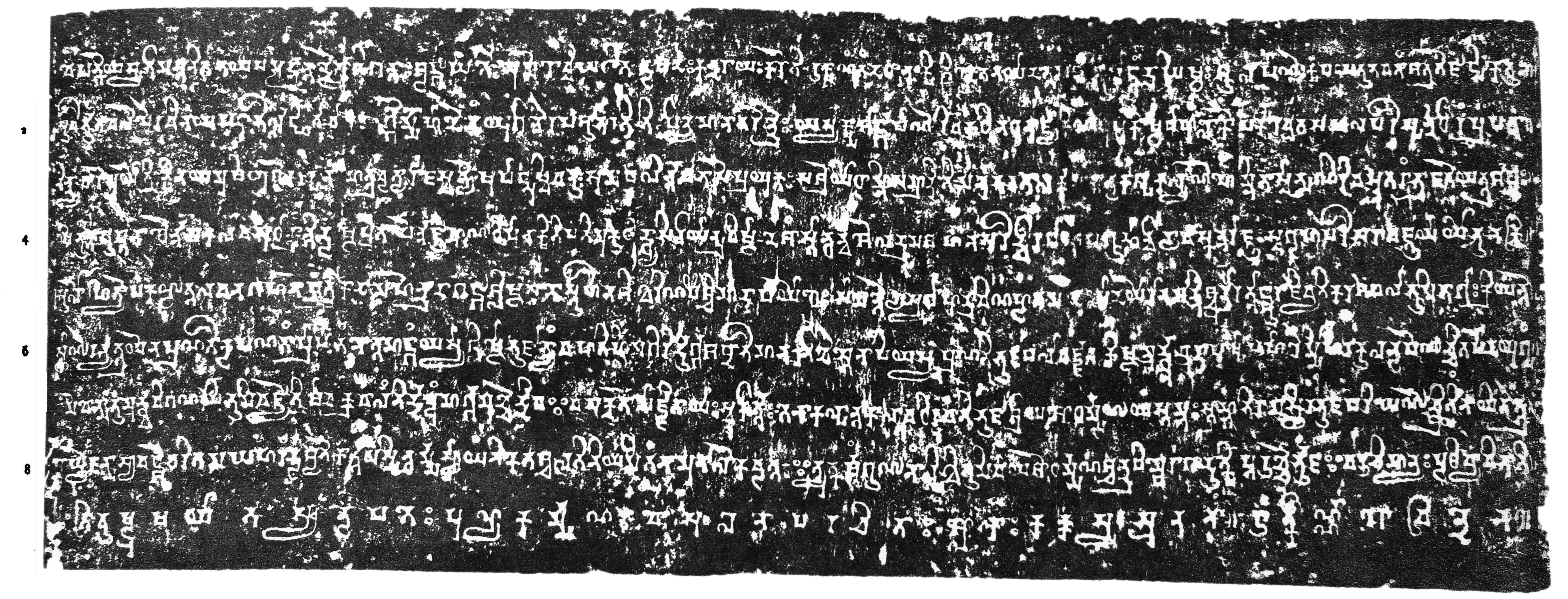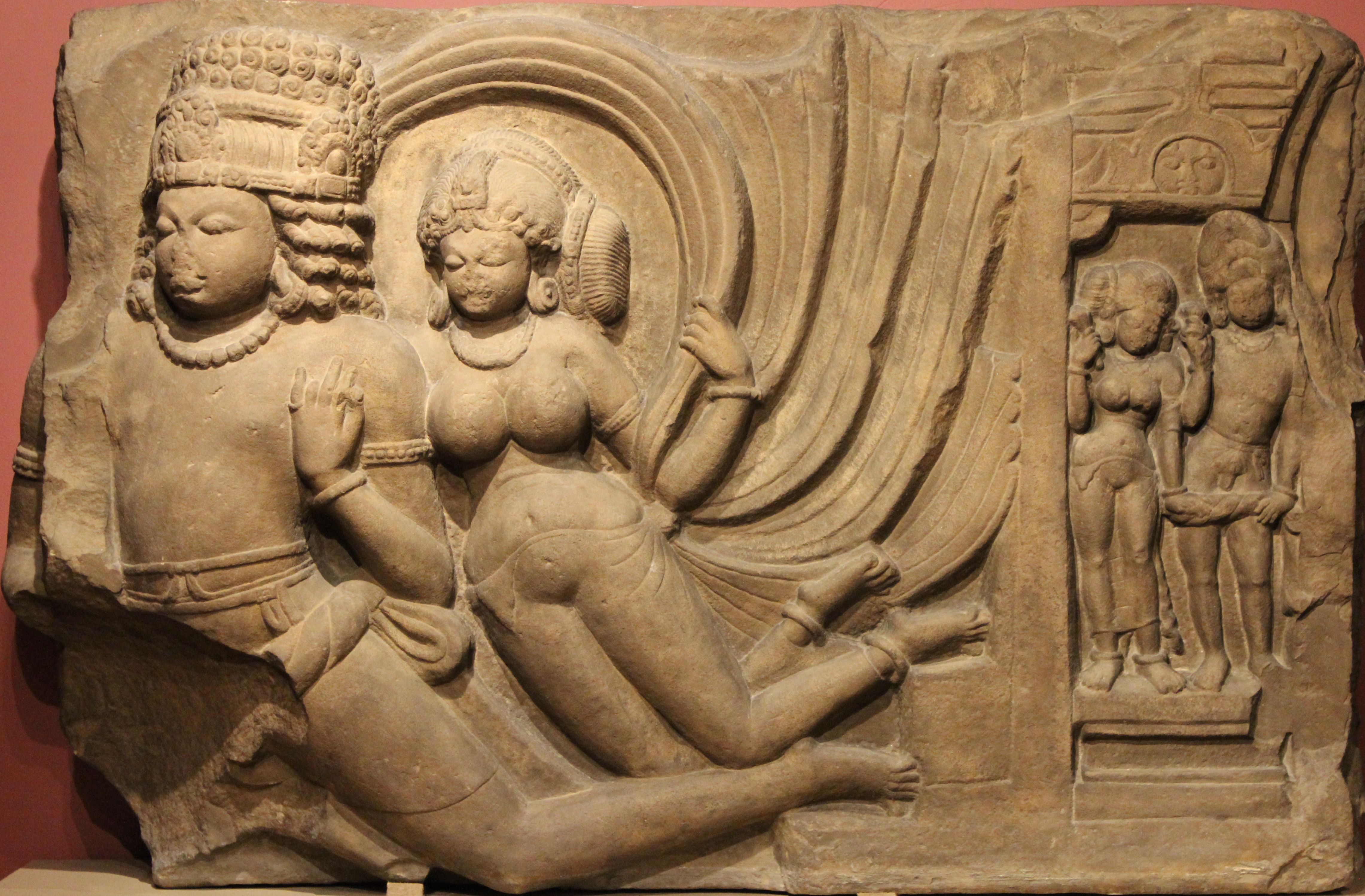|
Sondani
Sondani (सोंधनी), also Sondhni, is a small village at a distance of about 4 km from Mandsaur situated on Mahu-Nimach Highway towards Mahu. Victory monuments (525 CE) The spot is famous for a series of monuments with inscriptions, established by Yasodharman (ruled 515 – 545 CE), who praised himself for having defeated the Alchon Hun king Mihirakula. The victory monuments consist in two pillars, with various other sculptural elements pointing to the existence of a former temple at this spot. Style The art and style of the sculptural remains at Sodani are considered as a good marker of the final period of Gupta art, being dated to the reign of Yasodharman (ruled 515 – 545 CE), and more precisely to about 525 CE. After that point and for the next centuries, Indian politics became extremely fragmented, with the territory being divided between smaller dynasties. The art of Sondani is considered as transitional between Gupta art and the art of Medieval India: it ... [...More Info...] [...Related Items...] OR: [Wikipedia] [Google] [Baidu] |
Yasodharman
Yashodharman (Gupta script: ''Ya-śo-dha-rmma'', ) (r. 515 – 545) was a ruler of Malwa, in central India, during the early part of the 6th century. He probably belonged to the Second Aulikara dynasty. He conquered much of the Indian subcontinent between c. 530-540 AD according to Mandsaur pillar inscription. History Towards the end of the 5th century, India came under attack from the Hunas. Yashodharman and possibly the Gupta emperor, Narasimhagupta, defeated a Huna army and their ruler Mihirakula in 528 AD and drove them out of India. Three inscriptions of Yasodharman have been found in Mandsaur. One of these, the Mandsaur stone inscription of Yashodharman-Vishnuvardhana is of samvat 589 (532 AD). Mandsaur stone inscription of Yashodharman-Vishnuvardhana (532 AD) The Mandsaur stone inscription of Yashodharman-Vishnuvardhana was written in 532 AD, and records the construction of a well by a person named Daksha in Dashapura (modern Mandsaur, also often spelled Mand ... [...More Info...] [...Related Items...] OR: [Wikipedia] [Google] [Baidu] |
Alchon Hun
The Alchon Huns, ( Bactrian: αλχον(ν)ο ''Alchon(n)o'') also known as the Alchono, Alxon, Alkhon, Alkhan, Alakhana and Walxon, were a nomadic people who established states in Central Asia and South Asia during the 4th and 6th centuries CE. They were first mentioned as being located in Paropamisus, and later expanded south-east, into the Punjab and central India, as far as Eran and Kausambi. The Alchon invasion of the Indian subcontinent eradicated the Kidarite Huns who had preceded them by about a century, and contributed to the fall of the Gupta Empire, in a sense bringing an end to Classical India. The invasion of India by the Huna peoples follows invasions of the subcontinent in the preceding centuries by the Yavana (Indo-Greeks), the Saka (Indo-Scythians), the Palava (Indo-Parthians), and the Kushana (Yuezhi). The Alchon Empire was the third of four major Huna states established in Central and South Asia. The Alchon were preceded by the Kidarites and succeeded by the ... [...More Info...] [...Related Items...] OR: [Wikipedia] [Google] [Baidu] |
Mandsaur
Mandsaur is a city and a municipality in Mandsaur district located on Border of Mewar and Malwa Malwa is a historical region of west-central India occupying a plateau of volcanic origin. Geologically, the Malwa Plateau generally refers to the volcanic upland north of the Vindhya Range. Politically and administratively, it is also syno ... region of Madhya Pradesh state of central India. It is the administrative headquarters of Mandsaur District. The ancient Pashupatinath Temple, Mandsaur, Pashupatinath Temple is located in Mandsaur. History Aulikaras of Dashapura Epigraphical discoveries have brought to light two ancient royal houses, who call themselves as Aulikaras and ruled from Dashapura (present-day Mandsaur). The first dynasty, who ruled from Dashapura from the beginning comprised the following kings in the order of succession: Jayavarma, Simhavarma, Naravarma, Vishvavarma and Bandhuvarma. The Risthal stone slab inscription discovered in 1983 has brought to li ... [...More Info...] [...Related Items...] OR: [Wikipedia] [Google] [Baidu] |
Mandasor Stone Pillar Inscription Of Yashodharman
Mandsaur is a city and a municipality in Mandsaur district located on Border of Mewar and Malwa region of Madhya Pradesh state of central India. It is the administrative headquarters of Mandsaur District. The ancient Pashupatinath Temple is located in Mandsaur. History Aulikaras of Dashapura Epigraphical discoveries have brought to light two ancient royal houses, who call themselves as Aulikaras and ruled from Dashapura (present-day Mandsaur). The first dynasty, who ruled from Dashapura from the beginning comprised the following kings in the order of succession: Jayavarma, Simhavarma, Naravarma, Vishvavarma and Bandhuvarma. The Risthal stone slab inscription discovered in 1983 has brought to light another Aulikara dynasty, which comprised the following kings in the order of succession: Drumavardhana, Jayavardhana Ajitavardhana, Vibhishanavardhana, Rajyavardhana and Prakashadharma. After Parakshadharma, the ruler of Mandsaur was Yashodharma, who is identified with Vishnuvard ... [...More Info...] [...Related Items...] OR: [Wikipedia] [Google] [Baidu] |
Sondani Inscription
The Mandasor Pillar Inscriptions of Yashodharman are a set of Sanskrit inscriptions from early 6th-century discovered at an archaeological site at the village of Sondani (सोंधनी), about 4 kilometers south of Mandsaur (Mandasor) in northwestern Madhya Pradesh, India. These record the victory of Aulikaras, Aulikara king Yasodharman over the Swastik Mihirakula. According to Richard Salomon, these are notable for "their outstanding literary, calligraphic and historical value". The Mandasor inscription praises Yasodharman, describes him as having rescued the earth from "rude and cruel kings of the Kali Yuga, Kali age, who delight in viciousness".Fleet, John F. Corpus Inscriptionum Indicarum: Inscriptions of the Early Guptas. Vol. III. Calcutta: Government of India, Central Publications Branch, 1888, 147-148. Fleet first published his translation of the inscription in 1888. The Fleet's translation of the inscription has been corrected by various scholars. Location The inscr ... [...More Info...] [...Related Items...] OR: [Wikipedia] [Google] [Baidu] |
Gupta Art
Gupta art is the art of the Gupta Empire, which ruled most of northern India, with its peak between about 300 and 480 CE, surviving in much reduced form until c. 550. The Gupta period is generally regarded as a classic peak and golden age of North Indian art for all the major religious groups. Gupta art is characterized by its "Classical decorum", in contrast to the subsequent Indian medieval art, which "subordinated the figure to the larger religious purpose". Although painting was evidently widespread, the surviving works are almost all religious sculpture. The period saw the emergence of the iconic carved stone deity in Hindu art, while the production of the Buddha-figure and Jain ''tirthankara'' figures continued to expand, the latter often on a very large scale. The traditional main centre of sculpture was Mathura, which continued to flourish, with the art of Gandhara, the centre of Greco-Buddhist art just beyond the northern border of Gupta territory, continuing to exert in ... [...More Info...] [...Related Items...] OR: [Wikipedia] [Google] [Baidu] |
Mihirakula
Mihirakula (Gupta script: , ''Mi-hi-ra-ku-la'', Chinese: 摩酰逻矩罗 ''Mo-hi-lo-kiu-lo''), sometimes referred to as Mihiragula or Mahiragula, was the second and last Alchon Hun king of northwestern region of the Indian subcontinent between 502 and 530 CE. He was a son of and successor to Toramana of Huna heritage. His father ruled the Indian part of the Hephthalite Empire. Mihirakula ruled from his capital of Sagala (modern-day Sialkot, Pakistan). In around 520 CE, the Chinese monk Song Yun met with Mihirakula. According to the 7th-century travelogue of the Chinese Buddhist pilgrim and student Xuanzang, Mihirakula ruled several hundreds of years before his visit, was initially interested in Buddhism, and sought a Buddhist teacher from monasteries in his domain. They did not send him a learned Buddhist scholar. Feeling insulted, he became anti-Buddhist and destroyed the monasteries in his kingdom.Li Rongxi (1996), ''The Great Tang Dynasty Record of the Western Regions'', B ... [...More Info...] [...Related Items...] OR: [Wikipedia] [Google] [Baidu] |
Vidyadhara
Vidyadhara(s) (Sanskrit , literally "wisdom-holders") are a group of supernatural beings in Indian religions who possess magical powers. In Hinduism, they also attend Shiva, who lives in the Himalayas. They are considered ''Upadeva''s, or demi-gods. In Hinduism In Hindu epics In the Hindu epics, Vidyādharas are described as essentially spirits of the air. They are described as doing different activities in the epics like gazing at human prowess with astonishment, strewing flowers watching a combat, rejoicing with music and laughter, crowned with wreaths and fleeing with their wives from danger. They possess great magical powers like the ability to diminish their size. They are endowed with epithets describing them as "doers of good and devoted to joy". They also live in Gandhamandhana mountain and other Himalayan mountains with Kinnaras. They are also described residing on Mount Krauncha, on Citrakuta where Rama saw Vidyadhara women playing, in the hills of Malabar and in ... [...More Info...] [...Related Items...] OR: [Wikipedia] [Google] [Baidu] |
Medieval India
Medieval India refers to a long period of Post-classical history of the Indian subcontinent between the "ancient period" and "modern period". It is usually regarded as running approximately from the breakup of the Gupta Empire in the 6th century CE to the start of the Early modern period in 1526 with the start of the Mughal Empire, although some historians regard it as both starting and finishing later than these points. The medieval period is itself subdivided into the Early Medieval and Late Medieval eras. In the Early Medieval period, there were more than 40 different states on the Indian subcontinent, which hosted a variety of cultures, languages, writing systems, and religions. At the beginning of the time period, Buddhism was predominant throughout the area, with the short-lived Pala Empire on the Indo Gangetic Plain sponsoring the Buddhist faith's institutions. One such institution was the Buddhist Nalanda University in modern-day Bihar, India, a centre of scholars ... [...More Info...] [...Related Items...] OR: [Wikipedia] [Google] [Baidu] |
Dvarapalas
A Dvarapala or Dvarapalaka (Sanskrit, "door guard"; IAST: ' ) is a door or gate guardian often portrayed as a warrior or fearsome giant, usually armed with a weapon - the most common being the ''gada'' (mace). The dvarapala statue is a widespread architectural element throughout Hindu, Buddhist and Jaina cultures, as well as in areas influenced by them like Java. Names In most Southeast Asian languages (including Thai, Burmese, Vietnamese, Khmer and Javanese), these protective figures are referred to as ''dvarapala''. Sanskrit ''dvāra'' means "gate" or "door", and ''pāla'' means "guard" or "protector". The related name in Indonesian and Malaysia is ''dwarapala''. Equivalent door guardians in northern Asian languages are ''Kongōrikishi'' or ''Niō'' in Japanese, ''Heng Ha Er Jiang'' in Chinese, and ''Narayeongeumgang'' in Korean. Origin and forms Dvarapalas as an architectural feature have their origin in tutelary deities, like Yaksha and warrior figures, such as Ac ... [...More Info...] [...Related Items...] OR: [Wikipedia] [Google] [Baidu] |
National Museum, New Delhi
The National Museum in New Delhi, also known as the National Museum of India, is one of the largest museums in India. Established in 1949, it holds a variety of articles ranging from pre-historic era to modern works of art. It functions under the Ministry of Culture, Government of India. The museum is situated on Janpath. The blue–print of the National Museum had been prepared by the Gwyer Committee set up by the Government of India in 1946. The museum has around 200,000 works of art, mostly Indian, but some of foreign origin, covering over 5,000 years. It also houses the National Museum Institute of History of Art, Conservation and Museology on the first floor which was established in 1983 and has been a university since 1989, running master's and doctoral level courses in art history, conservation and museology. History In 1946, the idea of building a National Museum for India was proposed by the Gwyer Committee. Sir Maurice Gwyer, the former chief justice of India and vice ... [...More Info...] [...Related Items...] OR: [Wikipedia] [Google] [Baidu] |










